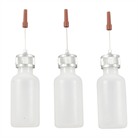Do you just put some drops on the metal and smear it around with your finger? Put it on a patch and rub it on? Maybe use a brush or cotton swab?
Yes.

All of those ways are acceptable.
Another way is to carefully drip a small amount of oil down between mating surfaces--just make sure not to get carried away with this. More people over-oil than under-oil, in my experience.
If I see internal areas showing heavy wear, especially where sliding friction is present, I will sometimes apply a small amount of a light grease to provide better/more persistant lubrication for that area. Be sure to use a grease that won't thicken in cold weather if your firearm is one that is used in harsh conditions, and don't overdo the grease. It doesn't run off or evaporate like oil does, and that means that at some point in the future, you'll probably have to manually remove it along with any debris/dust/fouling that has collected and replace it with fresh lubricant.
You should lubricate:
1. Places that your firearm's manual states that you should oil.
2. Places that show noticeable wear marks after use--assuming that there's no prohibition in your manual against oiling those areas.
3. Any metal surfaces that you wish to protect from rust/corrosion. These areas should receive a light coat applied with a lightly oiled rag. All you need here is just enough to see that the surfaces aren't dry. There should never be enough to make the surface actually wet for this particular application.
You should not lubricate:
1. Places that your manual states should remain free from lubrication.
2. Areas which, if lubricated, would make it hazardous to handle your firearm.
3. Areas which come into direct contact with loaded ammunition should only be lightly oiled, if at all.
4. Areas which don't require oil and are likely to collect dust/debris/lint. The inside of stainless steel or polymer magazine tubes, for example, often don't really need any lubrication at all. Some blued magazine tubes might need some protection against corrosion. Those are often better protected by wiping them with a silicon-impregnated rag to help prevent corrosion rather than applying a liquid oil to them. The liquid oil could collect debris/dust/lint which might jam the magazine.


